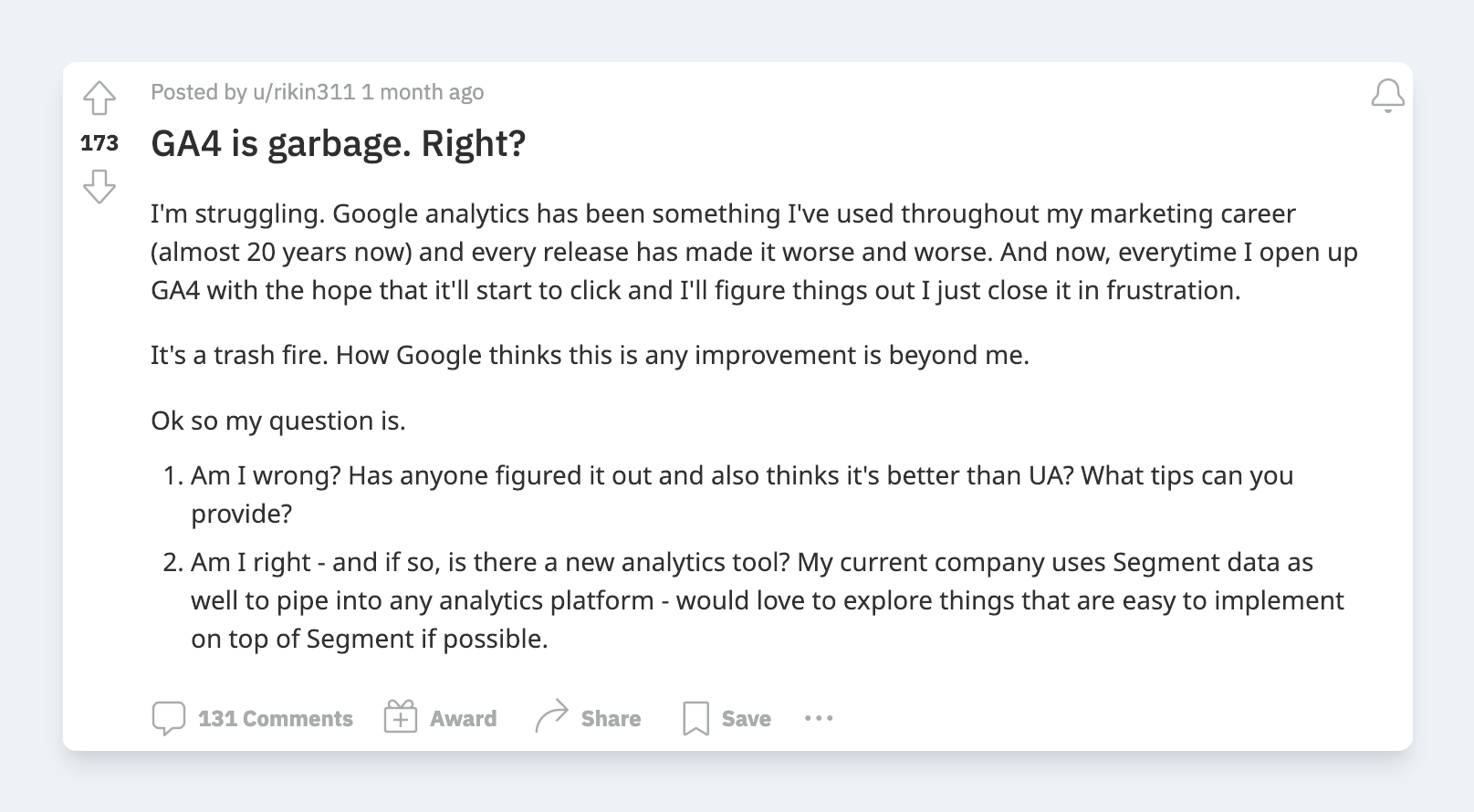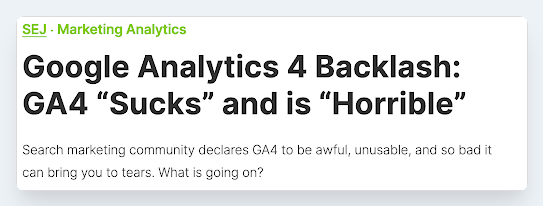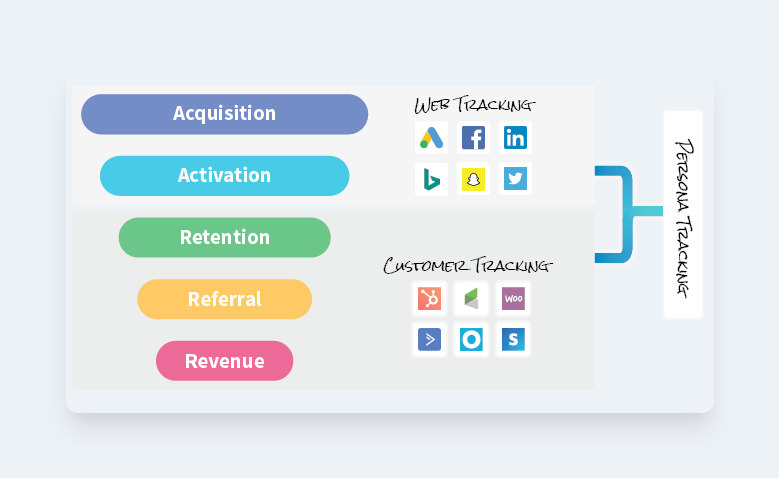Google Analytics (specifically Universal Analytics) will always have a special place in my heart as a marketer. Universal Analytics was the Swiss army knife of digital marketing tools. It sliced, diced, and gathered a wealth of data to guide your marketing strategies.
Sure, marketers stretched it to its breaking point, and the underlying technology of visitor IDs and cookies breaks down with longer sales funnels. However, Universal Analytics was still a great tool that got the job done for millions of marketers and business owners.
Google Analytics 4? Eh, not so much.
GA4 is a powerful analytics tool, but marketers don’t appreciate the version that Google rolled out forcefully, and many are searching for an alternative to GA4.
Like this popular post from /r/marketing on Reddit:

Or this article from Search Engine Journal:

Why aren’t marketers happy with GA4?
Marketers grapple with the challenges that Google Analytics 4 presents, including:
- Usability: GA4 has a steep learning curve, making it difficult for those who’ve built up proficiency with Universal Analytics to adapt quickly.
- Data Lag: GA4 often experiences a delay in data reporting, typically ~12-24 hours.
- Missing or Hidden Features: Some readily available features and easy to find in Universal Analytics are either missing or not readily accessible in GA4.
- Data Discrepancies: Differences in attribution models and tracking setups can lead to discrepancies in data in GA4. Remember that campaign where GA showed 50 conversions, but Google Ads recorded 60? That’s a data discrepancy.
- Limited Educational Resources: While there are paid courses about GA4, comprehensive publicly available documentation for GA4 is lacking, making it harder to understand the platform entirely.
But, most frustratingly, is the fact that Google Analytics 4 still isn’t good at tracking your entire marketing funnel! If you’re a digital marketer looking to maximize your online revenue, you must know how your whole funnel performs. Google Analytics 4, unfortunately, is still limited to tracking your top of the funnel.
But GA4 and UA aren’t your only options. Enter: SegMetrics.
Wondering what sets SegMetrics apart from Google Analytics? Let’s look at these popular funnel stages/steps and compare how Universal Analytics, Google Analytics 4, and SegMetrics perform.
| Universal Analytics | GA4 | SegMetrics | |
| UTM Data | Yes | Yes | Yes! SegMetrics effectively captures UTM parameters, allowing for precise source tracking |
| Ad Spend | Only Google Ads | Only Google Ads | Yes! SegMetrics integrates with over 15 ad platforms, ensuring a comprehensive view of your advertising expenses |
| Goals Completions | Yes | Yes (as conversions) | Yes! Track goal completions seamlessly with SegMetrics. |
| Bounces | Yes | No (replaced with engaged sessions) | No, this is something best tracked in another tool |
| Email interactions | X | X | Yes! With SegMetrics, monitor your subscribers’ engagement levels by tracking their interactions with your emails |
| Webinar attendance | X | X | Yes! Keep tabs on your audience’s interest by gauging webinar attendance through SegMetrics. |
| On-site purchases | Yes | Yes | Yes! SegMetrics offers detailed insights into on-site purchases, ensuring you understand your sales performance. |
| Off-site purchases | If integrated | If integrated | Yes! Whether a sale happens on your site or elsewhere, SegMetrics ensures every transaction gets counted. |
| Attribution window | 30 Days | Configurable (up to 90 days for conversions) | Yes! With Lifetime Attribution — Forget limited tracking periods; SegMetrics offers lifetime attribution, providing a holistic view of customer journeys. |
| Subscription revenue | X | X | Yes! Monitor recurring revenue streams effortlessly with SegMetrics, tracking every subscription payment. |
| Repeat purchases (LTV) | X | X | Yes! Understand customer loyalty and value with SegMetrics by tracking repeat purchase patterns. |
| Refund rate | X | X | Yes! Keep your finger on the pulse of customer satisfaction with SegMetrics’ refund rate tracking. |
| Multi-purchase attribution | X | X | Yes! With SegMetrics, delve into a customer’s full purchasing history, understanding the value and sources of each sale. |
GA4: Great at Top Of Funnel/Web Tracking
Google Analytics 4 emphasizes top-of-funnel analysis. It can track who is landing on your website and how they interact with it (like which pages they visit and how long they stay). That makes GA4 a great choice if you only want to measure your top-of-funnel stages — like ‘Acquisition’ and ‘Activation’ — or have questions about your site’s user interface or elements that could stop people from buying.
GA4 can also track some initial conversion events (if you’ve set up conversion tracking), like when a user:
- Downloads a PDF
- Completes a purchase
- Signs up for a newsletter
GA4 can record the UTM data and goal completions for people who complete actions like the above, but GA4 won’t collect data on people who never join your funnel.

SegMetrics: Best for Middle of Funnel
Google Analytics stops tracking your visitors once they leave your website.
Your systems move your visitors, subscribers, and customers into your email marketing platform or CRM.
Unfortunately, those marketing data silos often overlook the original context of those individuals (like the lead magnet that attracted their attention, the ad they clicked on, or their original traffic source/medium).
Google Analytics 4 will only tell you that someone joined your funnel but won’t help you see which visitors moved through your email sequence or another middle-of-funnel activity.
SegMetrics can bridge these different marketing tools and data silos.
With a tool like SegMetrics, which utilizes person-based analytics, you can neatly stitch together top-of-funnel and middle-of-funnel insights for every single one of your subscribers, all tied to a unique contact ID.
With that foundation, you can optimize your marketing using these impactful details, like how prospects from different ad campaigns interact with your email sequence or webinars.
SegMetrics: Best for Bottom of Funnel
Google Analytics 4 falls short when measuring long-term customer behavior.
Sure, you can set it up to measure purchases made on your website with some multi-touch attribution. However, GA4 struggles to track details accurately, such as if a customer makes a repeat purchase (especially from a different device).
SegMetrics excels at answering these bottom-of-funnel questions.
With SegMetrics, you’ll see each person’s engagement and transaction history tied to their unique contact ID. Repeat purchases or off-site transactions will be connected, no matter if those transactions happen months (or years) later.
SegMetrics even records your refunds and cancellations, so you can see which customer segments aren’t converting from a free trial to a paid subscription (or are returning products for a refund) and adjust your marketing strategy.
SegMetrics: Superior for Multi-Purchase Attribution
Google Analytics 4 tracks individual purchases back to earlier touchpoints within its limited attribution windows (90 days). However, GA4 struggles with complete sales cycles and average lifetime value comparisons. Many marketers view its data as a “black box,” because it often has discrepancies and doesn’t align with other platforms, given variations in attribution models and tracking setups.
SegMetrics provides robust multi-purchase attribution with a lifetime duration, allowing you to attribute a customer’s lifetime spend back to the original source, ad, or campaign. SegMetrics users often discover that not all leads are created equal and that some sources or campaigns bring in customers that spend 3-4x more over their lifetime.
SegMetrics’ enhanced multi-purchase attribution allows you to look beyond an isolated sale to understand where your revenue came from. By tying this data to individual customers, SegMetrics can help you see exactly where they came from and what helped them convert.
SegMetrics: Track Your Marketing Changes via the Marketing Changelog
Do you ever look back at your marketing data and rack your brain, trying to remember what experiment, test, or campaign caused that spike?
You used to be able to track that with Google Analytics (Univeral Analytics) via Annotations. Unfortunately, that feature is no longer available in Google Analytics 4, leaving marketers without a convenient way to document and track the changes they made to their marketing – be it launching a new page, adding a pop-up, or switching to a different call to action.
SegMetrics’ Marketing Changelog shines here. This feature records every change made to your website or marketing, allowing you to directly track its impact.
“By the way, your ‘marketing log’ in SegMetrics? Oh my gosh, so simple and so good. The new Google Analytics got rid of notations, so you can’t do any of this anymore. Your implementation is so good, so simple, and crosses all the mediums together. This feature is my new favorite!” — Brian Grayson, Digital Age Marketer
Bottom Line: Use GA4 if you want to measure your website interactions and SegMetrics for complete funnel analytics
We aren’t saying you should completely abandon Google Analytics 4. It proves valuable when you need to track user behavior on your website — we’re running it ourselves to measure how people engage with SegMetrics.io.
Opt for Google Analytics 4 if you want to understand user interactions, pinpoint user origins, and see how users navigate your website. GA4 provides valuable insights into user behavior, individual page performance, and funnel progression within your site.
But if you’re looking for a comprehensive full-funnel analytics solution — including middle and bottom-of-the-funnel activities and metrics — then choose SegMetrics. SegMetrics helps you measure details like:
SegMetrics delves deep into customer behavior across multiple platforms and connects data from your CRM, payment providers, and advertising platforms.
To give your revenue a boost, start your journey with SegMetrics today:
- Register for a 14-Day Free Trial of SegMetrics
- Integrate your systems and import your marketing data
- Dive into immediate insights
Plus, your SegMetrics account also comes with a complimentary Data Setup Call, where one of our marketing consultants will walk through your marketing integrations with you, verify the correct data is flowing into SegMetrics, and help you get started with Segmetrics.






